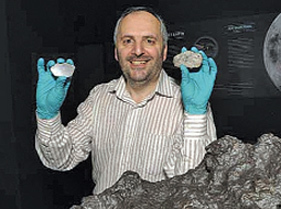ONE of several pieces of rock taken from the moon by Neil Armstrong
and Buzz Aldrin and worth over $5 million is believed to be buried in Dunsink
Dump in Finglas.
When the astronauts of Apollo 11 touched down on the
moon in 1969, they brought back numerous samples of the lunar surface, which
were given as a goodwill gesture to nations across the globe.
The lunar rock that was given to Ireland was placed in
Dunsink Observatory for safekeeping. However, the precious stone went missing
after a blaze gutted the observatory back in 1977.
It’s believed that it may have spent over 30 years as
a very pricey piece of rubbish buried with the rest of the debris from the fire
across the road in Dunsink landfill.
While the rock’s significance is immense, its’
monetary value is estimated to be in the region of $5 million based on what one
fifth of a gram of moon rock sold for back in 2003.
But before you don your gloves, grab a shovel and head
for Dunsink it’s worth considering the challenge.
The tip head is a sea of the city’s rubbish roughly 10
times the size of Croke Park. Its waste is 40 metres in depth and measures a
mammoth four million tonnes but it is perhaps the only municipal dump in the
world that is home to a piece of the moon.
Stargazer David Moore of Astronomy Ireland said not
even he would be that desperate to lay claim to a piece of the moon.
“You’d have to be an idiot to want to sift through
that much rubbish to find what looks like an indistinguishable piece of rock
worth $5 million,
? he told Northside People.
“There have got to be easier ways of making money.
It’d effectively be one dollar per tonne of rubbish which is not commercially
viable.
?
Mr Moore counts himself lucky to have touched the moon
rock from Apollo 11 when it was Dunsink Observatory.
“I can actually say that I’ve touched the moon,
? he
said.
“I was an astronomy student at the time and lived not
too far from the observatory.
“Three years later I worked in the observatory as a
summer student.
?
Mr Moore is sceptical that the rock even survived the
fire, which completely gutted the Meridian Room.
“It was mounted on a wooden plaque and encased in
plastic which would have been effectively fuel to any fire.
?
It’s thought that the moon rock was an after thought
following the devastating fire in the Dunsink observatory.
The moon rock was swept up with the rest of the debris
from the fire and taken to the dump across the road.
“At that time people had no idea of the monetary value
of such a rock,
? Mr Moore explained.
“They’re weren’t people buying or collecting moon rock
so it was effectively priceless until Russia auctioned off their moon rock in
1993.
?
Ireland isn’t the only country to have misplaced
precious moon rock. It’s thought 70 other samples from Apollo 11 are missing.
This information came to light recently following
research by Joseph Gutheinz, a former NASA agent, who is carrying out a study
to find out what has become of all moon rocks presented from the Apollo 11
mission.
Despite Ireland being a little red-faced over the loss
it comes as some consolation to know that we still have one piece of moon rock
presented following the Apollo 17 mission, which is in safekeeping in the
National Museum.
